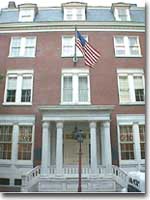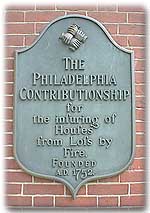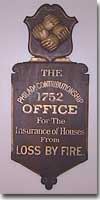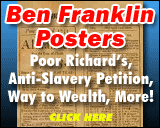

Insurance: Philadelphia Contributionship: Page 1
Founded by Franklin in 1752

After that blaze, the Common Council of Philadelphia ordered fire equipment imported from England. Leather buckets, fire hooks, ladders, and engines were distributed at strategic points around town. A local resident even built his own fire-engine which "threw the water much higher" than the London models.

Franklin, in his Gazette, gave suggestions on fire safety: "In the first Place, as an Ounce of Prevention is worth a Pound of Cure, I would advise 'em to take care how they suffer living Coals in a full Shovel, to be carried out of one Room into another, or up or down Stairs, unless in a Warmingpan shut; for Scraps of Fire may fall into Chinks and make no Appearance until Midnight; when your Stairs being in Flames, you may be forced, (as I once was) to leap out of your Windows, and hazard your Necks to avoid being oven-roasted."
In a Gazette article of 1733 Franklin noted how fires were being fought. "Soon after it [a fire] is seen and cry'd out, the Place is crowded by active Men of different Ages, Professions and Titles who, as of one Mind and Rank, apply themselves with all Vigilance and Resolution, according to their Abilities, to the hard Work of conquering the increasing fire."
Good-will and amateur firefighters were not enough, though. Franklin suggested a "Club or Society of active Men belonging to each Fire Engine; whose Business is to attend all Fires with it whenever they happen."

The logical next step was to form a fire insurance company. In 1751, Franklin and members of his Union Fire Company met with firefighters from other brigades for such a purpose. Over several meetings, insurance articles were discussed, drawn up, and presented publicly. All interested in subscribing to the project were told to sign a Deed of Settlement. The first to sign, Governor James Hamilton, was the son of famed "Philadelphia lawyer" Andrew Hamilton. Directly below Hamilton's signature are those of Benjamin Franklin and Philip Syng. Initially, over 70 prominent Philadelphia citizens became subscribers. On April 13, 1752, these men came together to elect a Board of Directors and Treasurer, who met for the first time on May 11, 1752.
At that meeting it was affirmed that those subscribed had agreed to establish an insurance company by the name of The Philadelphia Contributionship for the Insuring of Houses from Loss by Fire, and "to be and continue to be Contributors unto and equal Sharers in the losses as well as the gains." A dozen Directors were elected to the board. Franklin's name headed the list, followed by Philip Syng.
Syng, yet another of those extraordinary early Philadelphians, was an eminent silversmith and creator of the inkstand from which the Declaration of Independence was signed. In addition to being a vestryman at Christ Church and a member of the Philosophical Society, Syng found time to design the corporate seal for The Contributionship. Policyholders were required to affix these metal fire marks on their houses. Today, in Philadelphia, fire marks adorn many older and newer houses like a boutonniere on a suit.
Several Quaker merchants served on the original Board as did Samuel Rhoads, the Master Builder of Pennsylvania Hospital — the oldest continually insured institution in the country. Rhoads became the firm's first Surveyor, assigned to inspect buildings and determine if they were appropriate risks for The Contributionship. Once the recommendations of the Surveyor were made, all Directors voted on whether a property should be insured. All this occurred at a monthly meeting, which continues to this day (there are 10 meetings each year, and, of course, the directors have different duties now). The first group of Directors, who came up for re-election yearly, decided to levy fines on themselves in cases of absence or tardiness from these meetings. Money from these fines accumulated and was earmarked for civic improvements. The earliest fine money went into making and placing mile markers between Philadelphia and Trenton. Today a weather-beaten mile marker can be seen in The Contributionship's garden, a reminder of the firm's philanthropic past.
The first policyholders took out policies for seven years. After expiration, the premium money was returnable, subject to certain exceptions. Fire losses and office expenses were paid with money taken from a proportionate contribution of each policyholder.



